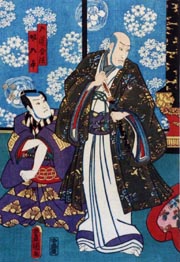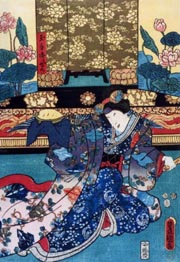| GAPPÔ |
| Play title | Sesshû Gappô-ga-Tsuji |
| Common title | Gappô |
| Authors | Suga Sensuke Wakatake Fuemi |
| History |
The play "Sesshû Gappô-ga-Tsuji" was originally written for the puppet theater (Bunraku) and staged for the first time in the 2nd lunar month of 1773 in Ôsaka at the Kitahorieza. It was adapted for Kabuki many years later and staged for the first time in the 6th lunar month of 1835 in Kyôto at the Kitagawa no Shibai [casting]. It was staged in Ôsaka and Edo for the first time respectively in the 3rd lunar month of 1839 at the Kado no Shibai [casting] and in the 9th lunar month of 1852 at the Ichimuraza [casting]. "The play has always been contentious and was indeed banned as late as 1937 on the grounds that a stepmother's love for her stepson was immoral" (Aubrey and Giovanna Halford in "The Kabuki Handbook"). |
| Structure |
"Sesshû Gappô-ga-Tsuji" is made-up of two acts. "Gappô" or "Gappô Anshitsu" (Gappô's Country Hermitage) is the final scene of the second act. |
| Key words |
Anshitsu Dokushu Gappô-ga-Tsuji Gidayû Kyôgen Jidaimono Katoku Sôzoku Raibyô Sesshû Settsu Teoigoto |
| Summary |
Gappô, a samurai who had given up his worldly career, retired to spend his days in a country retreat, where he devoted himself to Buddhist meditation and devotions. For this reason he lived in a simple cottage where he was attended by his wife Otoku. Their daughter Otsuji, a girl of nineteen, was married to a widowed nobleman and took the ceremonial name Tamate Gozen. Her husband had two sons, Takayasu Shuntokumaru, his rightful heir, and Jirômaru, an illegitimate son but adopted into the family. Jirômaru schemed to kill his brother and so succeed to the inheritance. Otsuji became the centre of scandalous gossip by falling in love with her stepson Takayasu Shuntokumaru, who was affianced to Princess Asaka. Otsuji, out of jealousy of the princess, gave Takayasu Shuntokumaru poisoned wine to drink, with the result that he was terribly disfigured and went blind. He fled with Asaka to Gappô's country retreat. Gappô, ashamed and horrified by the stories of his daughter's immoral conduct, declared her dead as far as her parents were concerned. He offered up Buddhist prayers for the departed, but Otsuji arrived to visit her parents. It is at this point that the play opens. When Otsuji reached her parent's home, Gappô at first refused to let her in, telling his wife that it must be an evil spirit making a visitation. Otoku, moved by maternal love, tried to make her husband change his mind, but he warned his wife that he would have to kill his daughter if she set foot in their house. Otsuji continued to plead from behind the door, saying that she had news which she could not disclose outside. At last Gappô grudgingly allowed his wife to admit the girl. Mother and daughter embraced, but Gappô remained aloof. Otoku then asked her daughter if the rumours about her misconduct were true. She was horrified when Otsuji shamelessly expressed undying love for Takayasu Shuntokumaru in the most romantic way. The speechless Gappô went off angrily to fetch his sword. On his return he furiously reminded his daughter of her duties and expressed disgust that, in the face of these, she should talk about marrying Takayasu Shuntokumaru. He was about to strike her down on the spot when his wife intervened. She asked of what use it was killing the girl and pleaded that his duty was to persuade his daughter to seek repentance by becoming a nun. Otsuji immediately exclaimed that she would far rather be a courtesan and charm Takayasu Shuntokumaru with her splendour. The angry Gappô was about to strike his daughter again, but his wife once more stayed his hand and, leading the girl off, said that she would reason with her in person. After this, the disfigured Takayasu Shuntokumaru appeared, led by his princess. The young man hoped that Otsuji would forget her passion when she saw his hideousness. On the contrary, Otsuji rushed into the room and tried to carry on a violent flirtation with Takayasu Shuntokumaru. There was a quarrel between Princess Asaka and Otsuji, and they fought like wildcats. Gappô rushed in on hearing the commotion and, overcome with anger and disgust, stabbed his daughter. As she lay dying, Otsuji revealed the secret of her strange conduct. Knowing that there was a plot to kill Takayasu Shuntokumaru, she had disfigured him in order to drive him from the house and to safety. When further questioned by Gappô as to why she had not revealed the plot to her husband, she answered that, in that case, Jirômaru the plotter would have been ordered to commit suicide. But he too was her stepson, and it was her duty as a mother to save both men. She concluded by saying that it was a magic potion she had given Takayasu Shuntokumaru. If he drank the life blood from a woman born at the same hour, day, month, and year as himself, he could be cured. She was that woman. Moreover, the cure had to be taken from the same vessel used for the original poison. Otsuji then produced the abalone shell in which she had previously administered the fatal draught. Gappô and the princess were overwhelmed and begged forgiveness at this revelation. Otsuji administered the coup de grâce herself and caused her blood to gush into the container. She died amidst her sorrowing family and, above their lamentations, cried that she would be in the Buddhist paradise on the morrow. Takayasu Shuntokumaru drank the blood and his disfigurement and blindness were miraculously cured. Source: A. C. Scott |
| Trivia |
There are two different sets of kata for the role of Tamate Gozen: one crafted by Nakamura Utaemon V and the other by Onoe Kikugorô VI. |
 |
 |
 |
|
The actors Nakamura Shibajaku I, Seki Sanjûrô III, Bandô Shûka I, Nakamura Fukusuke I and Nakamura Kamenojô I playing the roles of the yakko Irihei, Gappô, Tamate Gozen, Takayasu Shuntokumaru and Princess Asaka in the drama "Sesshû Gappô-ga-Tsuji", which was staged in the 9th lunar month of 1852 at the Ichimuraza (print made by Utagawa Toyokuni III) |
||
|
|
| Contact | Main | Top | Updates | Actors | Plays | Playwrights | Programs | Links | FAQ | Glossary | Chronology | Illustrations | Prints | Characters | Derivatives | Theaters | Coming soon | News |